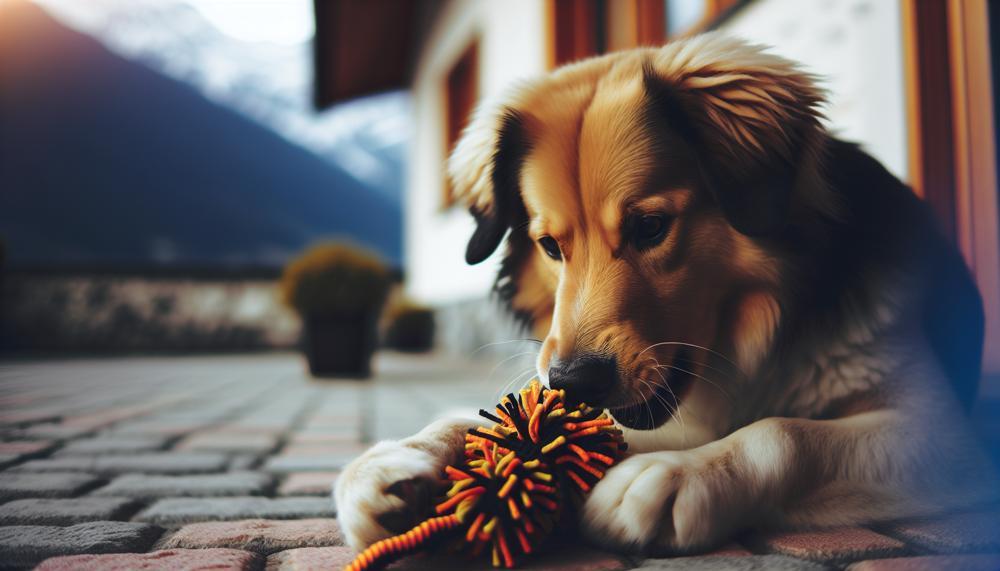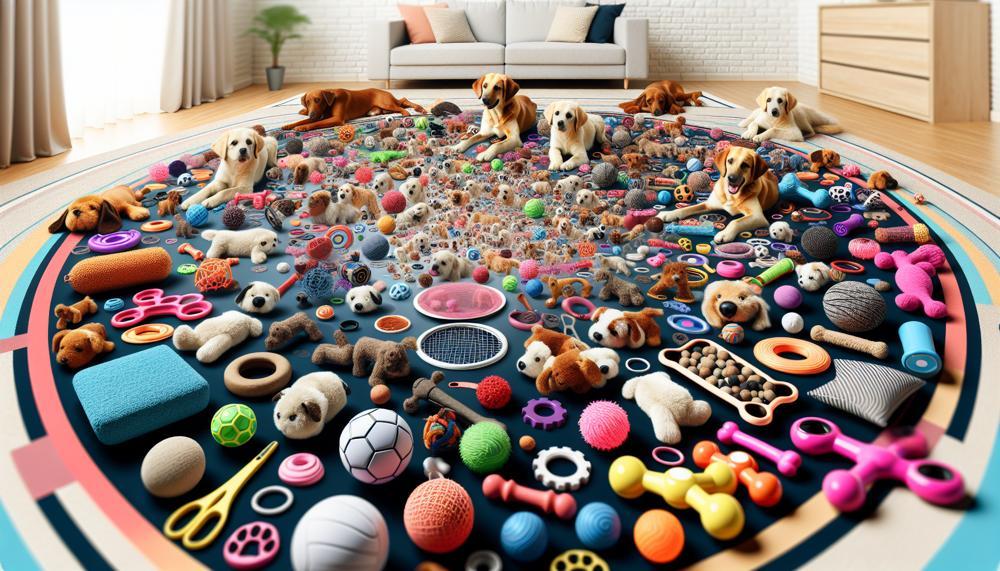Imagine this: you arrive home after a long day at work, exhausted and ready to unwind. As soon as you open the door, your beloved furry companion greets you with a toy in their mouth, tail wagging excitedly. You may have pondered the reason behind this seemingly adorable and endearing behavior.
Well, wonder no more because we’re about to explore the intriguing question of why our canine companions bring us toys.
In this blog post, we’ll explore dogs’ toy-bringing behavior. We’ll discuss its significance in the human-dog relationship. Various factors contribute to this lovable habit, from innate instincts to emotional connections.
Get ready to discover:
- The evolutionary origins of dogs’ toy-bringing behavior
- How it strengthens the bond between owners and their furry friends
- The different meanings behind specific types of toys
- Practical tips for encouraging or discouraging this behavior in your own dog
Grab a cup of coffee, or your pup’s favorite treat, and join us. We’ll unravel the mystery of why dogs bring their owners toys.
What Does it Mean When Your Dog Brings You a Toy?
Table of Contents
This behavior might show affection, seek attention, initiate playtime, or relieve boredom or anxiety. Let’s delve deeper into these reasons.
Demonstrating Affection and Gratitude
Canines are renowned for their unwavering loyalty and love towards their owners. Bringing a toy to their owner can be seen as a way to express their affection and gratitude for the care and attention they receive.
This behavior can also be seen as a “gift-giving” gesture. Dogs may see their toys as prized possessions and eagerly share them with their cherished humans.
Seeking Positive Responses
Dogs are highly attuned to their owner’s emotions and often respond well to positive reinforcement.
When a dog brings a toy to their owner, they may be seeking praise and attention. This reinforces the behavior and encourages them to continue doing it.
Initiating Playtime
Dogs are active animals that require both mental and physical stimulation. Bringing a toy to their owner can be a way for them to initiate playtime and engage in activities that they enjoy.
This behavior also strengthens the bond between dog and owner. They spend quality time together.
Relieving Boredom and Anxiety
Dogs may bring toys to their owners when they are feeling bored or anxious. It provides them with an outlet for their energy and helps alleviate any negative feelings.
This is particularly common in dogs who are left alone for extended periods of time.
Nesting or Resource Guarding Behaviors
In some cases, female dogs may exhibit nesting behaviors and treat toys as “puppies” during false pregnancies.
Additionally, some dogs may become possessive of their toys or other possessions. This can be a sign of resource guarding. It is crucial for owners to address these behaviors early on to prevent any potential aggression.
How to Respond When A Dog Brings You a Toy
When your dog brings you a toy, there are several helpful ways to react.
These reactions strengthen the bond between you and your furry friend. They also address any potential issues that may arise from this behavior.
- Positive Reinforcement: One of the most common reasons dogs bring toys to their owners is to receive positive reinforcement. When your dog brings you a toy, respond with enthusiasm and praise to show your love for them. This will encourage them to continue this behavior and strengthen your bond.
- Engage in Playtime: Dogs often bring toys as a way to initiate playtime with their owners. Take this as an opportunity to bond with your dog and spend quality time together. Playing with toys can also provide mental and physical stimulation for your dog, promoting their overall well-being.
- Teach Commands: Dogs are intelligent animals and can learn to associate certain commands with specific behaviors. Use this behavior as an opportunity to teach commands like “drop it” or “take it” by offering treats in exchange for the toy. This not only strengthens your dog’s obedience skills but also enhances your relationship.
- Address Resource Guarding: If your dog shows signs of resource guarding, where they become possessive of their toys, it is crucial to address this behavior early on through training and desensitization. Seek guidance from a professional trainer if needed to ensure the safety of both you and your furry friend.
- Show Gratitude: Dogs may also bring toys as a way to show off or share with visitors they like. Show gratitude for their thoughtfulness by thanking them. Play with the toy together. This not only strengthens the bond between you and your dog but also promotes positive socialization skills.
- Understand Their Needs: Pay attention to your dog’s body language and understand their needs when they bring you a toy. They may be seeking attention, feeling anxious, or simply wanting to spend time with you. By understanding their needs, you can strengthen your relationship and ensure their overall well-being.
Does Your Dog’s Breed Affect the Toy-Bringing Game?
The breed of your dog can greatly influence their behavior in the beloved toy-bringing game. Each breed has its own unique set of instincts and motivations. These drive them to bring toys to their owners.
By understanding these differences, you can deepen your bond with your furry friend. You can also create a more fulfilling playtime experience for both of you.
Retrievers and Herding Breeds
Breeds like Labradors, Golden Retrievers, and Border Collies have been selectively bred for generations. They are bred to retrieve and herd objects. It’s no surprise that these breeds excel at the toy-bringing game.
Their athletic builds and high energy levels make them perfect for fetching games. Their natural instincts drive them to chase and retrieve objects with great enthusiasm. This makes them highly motivated to play this game with their owners.
Toy Breeds
Smaller breeds like Yorkies and Chihuahuas may also excel at the toy-bringing game, but for different reasons.
These petite pups are known for their affectionate nature. They may bring toys to their owners as a way to bond and show love.
It’s also a way for them to engage in interactive play. It provides both mental stimulation and physical exercise.
Non-Sporting Breeds
On the other hand, non-sporting breeds such as Bulldogs and Dalmatians may not be as interested in playing the toy-bringing game.
These breeds were not originally bred for hunting or retrieving tasks. They may not have the same natural instincts or motivation to participate in this game. However, every dog is an individual. Some non-sporting breeds may still enjoy playing fetch with their owners.
The Importance of Toy Selection
The type of toy your dog brings can also give insight into the type of play they desire. Soft plush toys may provide emotional comfort, while balls and tug-of-war ropes stimulate their hunting instincts.

Squeaky toys can also be engaging for dogs. They mimic the sounds of prey, inviting a primal game of hunt.
Keep an eye on the types of toys your dog brings. Consider incorporating a variety to keep playtime interesting and engaging for them.
What Does the Type of Toy Reveal?
The type of toy your dog brings you can offer insight into their playtime preferences and needs. Each dog has unique instincts and motivations when it comes to play. Their choice of toy can reveal what type of play they crave.
For instance, soft plush toys can provide emotional comfort and satisfy the nesting instincts of dogs. Balls and tug-of-war ropes stimulate their chasing and hunting instincts.
Squeaky toys, on the other hand, mimic the sounds of prey and can be highly engaging and fulfilling for dogs.
Moreover, the type of toy your furry friend brings you can also indicate specific desires or needs, such as playing a particular game or engaging in a primal hunting activity.
If your dog consistently brings you a certain toy, it could mean that they have a strong desire to engage in that specific activity. This may also suggest that they associate that toy with positive experiences and rewards.
Understanding the type of toy your dog chooses to bring you can also help strengthen your bond with them. By providing them with toys that cater to their instincts and desires, you are promoting a positive and fulfilling playtime experience for both you and your furry companion.
Below is a table summarizing the potential wants and needs that different types of toys can reveal in dogs.
| Toy Type | Potential Want/Need Revealed |
| Plush Toys | Emotional Comfort and Satisfaction of Nesting Instincts |
| Balls/Tug-of-war Ropes | Stimulation of Chasing and Hunting Instincts |
| Squeaky Toys | Mimicking of Prey Sounds and Engagement in Primal Hunting Activity |
Conclusion
In conclusion, the act of a dog bringing their owner toys is a multi-faceted behavior. It serves various purposes. It can be seen as a display of affection. It’s also a way to seek attention. It’s an invitation for playtime. It can even be a coping mechanism for boredom or anxiety.
This innate behavior is deeply rooted in canine instincts. It serves as a form of communication between dogs and their owners. It strengthens their bond.
Understanding the reasons for this behavior can help us address any potential issues. It can also improve our pets’ well-being.
It’s also important to note that a dog’s breed can greatly influence their tendency to bring toys.
Each breed has unique instincts and motivations when it comes to play. It’s crucial to pay attention to the type of toy your dog brings you.
This simple gesture can provide valuable insight into their needs and desires. It allows you to provide them with a fulfilling playtime experience.






